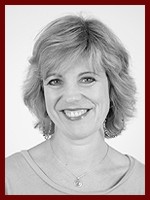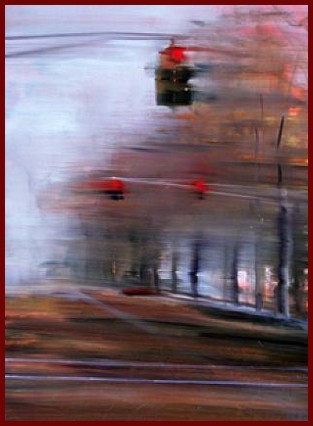Award Winning Painter, Barbara Friedman

There is a universe in Barbara Friedman's recent paintings - half Heraclitus, half Heisenberg - where anything can happen and it's happening right now.
Hovering between Heraclitus and Heisenberg, Barbara Friedman's recent paintings confront the viewer with a certain uncertainty. As painterly embodiments of the ancient Greek philosopher's assertion that "Nothing endures but change," the new works accomplish the seemingly self-contradictory task of freezing time and motion while simultaneously conveying their existence as phenomena. And though apparently depicting traditional scenes and events - Passing Truck; Pink Garage; Blue Trampoline - Friedman portrays a non-deterministic universe, a world of probability and potential similar to the vision promulgated by quantum mechanics. Somewhat contradictory to the "observer effect" that is often linked to Heisenberg's uncertainty principle, however, in the case of Friedman's work, the viewer rather than the event is transformed.
Writing about her recent work, Barbara Friedman states:The paintings examine the vagueness of appearancesPassing By, the artist's first solo show with Michael Steinberg Fine Art, is a vibrant amalgam of the tradition of American landscape painting and contemporary concerns with the impact of photography, film and video. In a recent essay about Friedman's work, the critic Lily Wei describes them as "a two-way exposition of time and memory cinematically formatted..."
and the need to keep renegotiating one's bearings.
As distillations of passing moments they speak to an
elevated sense of mortality but also a feeling of being
optically over-powered.
Barbara Friedman was born in New York City, where she currently lives and works. She received her BFA from the Rhode Island School of Design, and her MFA from the University of California - Berkeley. She has had numerous solo and group exhibitions, and is currently Professor of Art at Pace University, New York, NY.
What I love about Barbara Friedman’s paintings is that they draw you right into the middle of your own world. When I look at her work I am always transported to a distant memory; to a place where I want to linger for awhile. When I have an opportunity to talk with Barbara, it is then too that I want to linger for awhile -
with her.
DR: Tell me about your life and about you work?
BF: I have always painted.
My work changed quite a bit after September 11th. It emptied out and became a lot more ephemeral. The over-arching narrative kind of disappeared.
I think that my paintings are about me trying to renegotiate my bearings, and even though I paint these pretty empty spaces, I think the pieces are more about time than space. In a sense I think that I am having a conversation with myself about the nature of time.
DR: What are you happiest about now?
BF: The first thing that comes to mind is my husband Nick and my kids.
I have two daughters who make me happy. One of my daughters is entering the tunnel of adolescence and the other one is sort of emerging out of it. It is fascinating and scary at the same time and it brings back a lot of memories. It's a nice rite of passage to be privy to. It's bitter sweet because one of my daughters is leaving home.
DR: What's that like for you?
BF: I am proud and sad. I am going to miss her. I know this is the right thing for her, but just the idea that I can't run up to her room in the middle of the night and have a conversation if we're both awake…
I am going to miss her.
DR: I understand. I am already thinking about that time for myself…
I am going to jump here a bit.
BF: That's cool. That's cool...
DR: Tell me about the last time that someone made you cry.
BF: Nothing comes immediately to mind and I am not somebody who doesn't cry.
It was a really embarrassingly sentimental movie. I do that more these days. Gosh, what was that movie?
In general I find that I start choking up really easily when I watch movies or listen to music, in a way that I never used to.
If I kind of circle back to my paintings, they are clearly about mortality. Well, I don't know about clearly but hopefully opaquely anyway, they are about time passing and mortality and that kind of stuff.
There is a way in which I am almost always on the brink of tears. Maybe my paintings are always on the brink of tears too. Anything can send me over the edge.
That movie was probably the last time I cried and not a fight or something like that. And it wasn't even a good movie….cheap sentimentality, contained within me, this weird kind of maudlin nostalgia. But not a nostalgia of anything specific. It's more about time passing and trying to make sense of it; trying to make sense of the world today and the confusion that is the world today.
What is going to happen to the world and the people in it?
All of that. Anything that triggers that makes me cry.
DR: How do you see that you fit into the world? What's your relationship to the world?
BF: I wish I were more proactive.
My show is called In Passing and I feel like I sit outside a little too much. There is a way in which I am sort of watching with a certain amount of disbelief and trying to register. I think that is what this work is about - trying to register what is in front of me and I am never quite sure that I am seeing what I am seeing. Even though my paintings are very benign, mundane situations, I think the inability to register what I see has to do with what is going on in the world. This work is kind of a metaphor for that.
I feel a certain paralysis. It would probably be good for me if I were more proactive.
DR: What do you feel that your paintings provide people?
BF: That is scary for me to say.
I hope that there is an emotional resonance and that a non-verbal connection occurs. I hope that there is some kind of integrity. Somebody said that my paintings are anxious paintings, anxiously painted.
DR: Was that a critic?
BF: No. It was a painter. I liked that he said that. I feel that there is a certain truth to what he said. Maybe both that anxiety and that indecision…I guess I am a questioner by nature. Maybe that question mark, I guess, is my contribution. I don't trust what I see and I don't think people should. I think that's important - for people to never rest too secure. I think it's important that people "look again" and not assume.
DR: What is one of the hardest things that you have ever had to do?
Barbara in her studio.
BF: I don't know.
I am so aware of other people's hardships that I am reluctant to try and locate my own.
I was a single Mom for awhile but I didn't find that a hardship. I actually enjoyed it. It wasn't my choice and it was hard to give up on the idea of an intact family but I don't want to think that it was the hardest thing.
The hardest thing for me to do now is to live with uncertainty and that is what my paintings are about. That has to do with the world today…I think just generally living with uncertainty on any front, whether it's in my family, globally, after 9/11 - all of that.
I remember my best friend, who is a psychoanalyst, telling me that I had to learn to live with uncertainty.
DR: Well, is there anything that you know for sure?
BF: No and I am so jealous of people who do. I have always been so jealous of people who do.
The first review that I ever had of my work was in the early '80's in the San Francisco Chronicle. This great critic who died and I think this might have been one of his last reviews said:
"She makes, of doubt, an article of faith."
That was his summation.
But that is not a great thing, you know?
DR: It's not? Is there anything that you believe is true?
Red Lights, 2004
BF: This is like... (Laughing) ...this is sort of like...
DR: It's a little bit of a different question...
BF: Go back to your last question.
DR: Is there anything that you know for sure?
BF: It is different.
What's interesting is that I married two philosophers so this clearly has been a life long issue. This is what defined me as a child - the inability to believe. It's not that I thought everybody was lying. It's more existential. I never believed in Santa Claus. I wanted to…
I think the inability to believe.
DR: So you believe in the inability to believe?
BF: No! I think the inability to believe is what defines me.
We were talking about tennis a little earlier. When I play tennis, I have a very hard time calling the ball "in" or "out". I'll look down and I'll have to make the call. But the second I make the call I am sure that I am wrong. I can't retain the belief in where the ball has landed. That is what my paintings are about - that slippage.
I think that a lot of kids are like that. I remember when I would fall asleep wanting someone to sit next to me, not so much for the company but just to know that there was life on earth and that we were alive. Then I would ask them to move, just physically to move their arm or something so that I knew...
DR: What do you hope?
BF: I don't know.
DR: Pardon me but I gotta go with this theme here...
BF: (Laughs)
What do I hope?
I have no problem loving or enjoying but yet there is obviously this huge vacuum or …
What do I hope?
I am sure I hope for world peace and things like that but I mean - LITERALLY. There is just this big question mark.
DR: Wow. I find that completely fascinating.
BF: Really? Why?
DR: Well...
BF: Are you surprised?DR: No.
Listening to you as an artist, I think that these inquiries that you are engaged in are provocative. So many people have ready made answers to a lot of complicated questions. For you there is a searching going on. I find that refreshing.
BF: I remember one of my friend's boyfriend said that we were both, my friend and I, incapable of making a statement. Every sentence ended with a question mark, speaking of searching.
DR: What are you good at?
BF: I think that I can be a good conversationalist because I think that I can connect interpersonally. I have always been pretty good at that, not that I want to be good at that.
I am good at finding the narrative in something and I guess that I am also naturally curious about people.
DR: A hundred years from now what do you want to be remembered for?
BF: You know, I don't really think about that!
I would love to be world famous - NOW - and have tons of people write and think about my work. It's a question I should ask myself more but the whole idea of dying or ending is all so nebulous.
I worry about the future in terms of my kids and their lives but it kind of stops there.
I don't really go there.
I don't really think about posterity. It's kind of weird. Maybe it's because -
I don't believe enough.
Yeah. Anyway...
Thanks Barbara!
Barbara Friedman on Target
by Mark Blickley
It was all about falling and failing and fleeing.
The Divided We Fall was severed from the United We Stand, a sliced sentence that cut into our most frightening vulnerability. Children of the Baby Boom were taught to duck and cover at impending explosions, not stand tall. Wouldn't standing tall simply turn us all into easier targets?
In this unconditional war waged against our city we New Yorkers assumed the role of targets, not combatants. Even our heroes weren't warriors but victims of falling debris and hot ash that buried and burned them inside their uniforms as they attempted to rescue those targeted within the Twin Towers.
The initial response to the terror from people of the city was an explosive display of patriotic banners and American flags that dripped down from thousands of window ledges and sprang up across thousands of motor vehicles. The many cars in motion decked out in dozens of fluttering flags reminded me of red, white and blue matador capes designed to distract danger away from the target in a furious attempt to avoid becoming a target.
On a street called Liberty, three hundred yards away from the fourteen hundred and fifty foot Twin Towers, is the home of artist Barbara Friedman.
September 11, 2001 would be an exciting day of firsts for each member of Barbara Friedman's family. For her eldest daughter Sabina, it would be the first time she rode the subway by herself to her private school in Brooklyn Heights. For Barbara's husband Nick Pappas, a philosophy professor at the City University of New York, it would be the first official day of his year long academic sabbatical. It would allow him to take their younger daughter Sophie to a morning of double firsts -- her first day of the first grade.
As for Barbara, September 11th was the culmination of a dream she had long lobbied for. It would be her first day of teaching art at Pace University in Manhattan, located close to Rudy Giuliani's office at City Hall and within easy walking distance from her home on Liberty Street. She had been teaching at the Pace campus in Upstate New York and was thrilled to begin a fresh semester sans the long commute out of the city.
On the morning of September 11th, Barbara was walking to work when she heard the sound of the first plane before it crashed into the second tallest building in America...
Read the complete article by clicking here...


